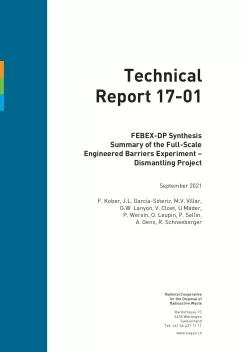
Technical Report NTB 17-01
FEBEX-DP SynthesisSummary of the Full-ScaleEngineered Barriers Experiment –Dismantling Project
This report summarises the results from the FEBEX in-situ experiment at the GTS. The full-scale heater test ran for over 18 years from the start of heating in 1997 to final dismantling ending in 2015. This report is one of the outputs from the FEBEX-DP project and culminates a series of Nagra work reports (NAB) covering different aspects of the FEBEX-DP project.
The FEBEX in-situ experiment was the longest-running in-situ full-scale heater experiment (the laboratory-based FEBEX mock-up test was started at the same time as the in-situ test and is still running, as of February 2022). Work on the project started in 1995 with the characterisation of the experimental rock volume, followed by the excavation of the FEBEX drift, further geosphere characterisation and the emplacement and instrumentation of the engineered barrier system (EBS) and plug. The initial total sealed test section comprised a total length of 14 m, which was filled with FEBEX (Serrata Clay) compacted bentonite blocks and embedding two steel heaters, each 4.5 m long and 0.9 m in diameter (11 tons weight) inserted in a liner. Heating started in 1997 and continued without interruption until 2002 when Heater #1 was removed during a partial dismantling activity, while Heater #2 was maintained at the same heating level. Heater #2 was switched off in 2015 and the section was fully dismantled and sampled. Throughout this time, the EBS and geosphere were continuously monitored and routine sampling was performed. During the partial (2002) and final (2015) dismantling, the EBS was characterised, providing a comprehensive dataset of EBS buffer properties (mineralogy, geochemistry, dry density, water content and thermo-hydro-mechanical (THM) properties), which allows a detailed evaluation of changes in the buffer during the early evolution of the EBS due to 18 years of heating and saturation.
Upon final dismantling, the buffer was close to full saturation with only a small, partially non-saturated volume remaining around Heater #2. The attainment of high saturation means that many of the most important processes associated with saturation had occurred and the buffer was close to reaching a reference state relevant to long-term safety assessment (albeit still in the thermal period). This allows assessment of safety-relevant aspects of the early evolution of such systems.
Special attention was paid to the characterisation of interfaces within the EBS and in the contact with the geosphere. These are of high importance as locations for likely alteration of material properties and were analysed in great detail.
Modelling of the in-situ experiment based on the detailed geosphere and buffer material characterisation allowed the prediction of the overall saturation progress and understanding of the key processes. Modelling performed at the start of the project was successful in predicting the observed evolution (monitoring) and final distribution of water content and dry density in the buffer and demonstrated the ability to represent the overall behaviour of a large full-scale system encompassing the ensemble of THM phenomena and their interactions. Multiple modelling approaches have been applied to the test and the dataset continues to be used as part of international modelling studies.
The monitoring and dismantling datasets from the in-situ experiment represent a unique resource for understanding the early evolution of the buffer during heating and natural saturation. This report provides an introduction and summary of the underlying reports and an initial synthesis of the results.
